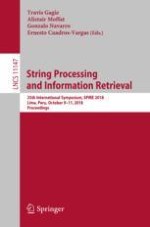2018 | Buch
String Processing and Information Retrieval
25th International Symposium, SPIRE 2018, Lima, Peru, October 9-11, 2018, Proceedings
herausgegeben von: Travis Gagie, Alistair Moffat, Gonzalo Navarro, Ernesto Cuadros-Vargas
Verlag: Springer International Publishing
Buchreihe : Lecture Notes in Computer Science
